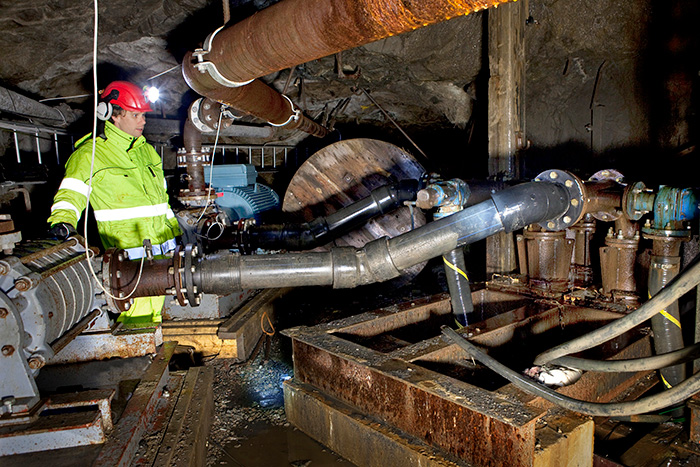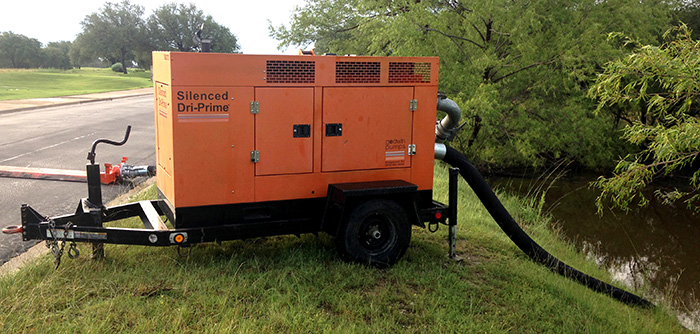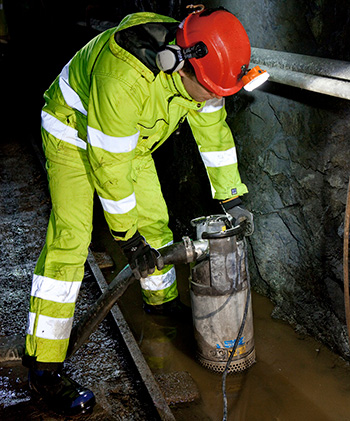 Image 1. A temporary pumping system assists the Dannemora iron ore mine in Sweden to return to operating conditions. (Courtesy of Xylem)
Image 1. A temporary pumping system assists the Dannemora iron ore mine in Sweden to return to operating conditions. (Courtesy of Xylem)The equipment rental market is growing as companies in sectors from municipal to mining turn to rental as a means of accessing the tools they need to get the job done.
According to a recent forecast by the American Rental Association (ARA), the U.S. equipment rental industry is poised for stable growth over the next few years, with projected total rental revenue increases of 6.6 percent in 2016 and 5.6 percent in 2017.
The trajectory is clear, but what is driving this trend? A combination of factors including climate change, an upturn in the global construction industry and contractors’ increased focus on decreasing operating costs means that equipment rental is gaining recognition as a viable and cost-effective alternative to purchase. Pump manufacturers are responding to this trend with a strategy to better meet the market demand from construction, industry, municipal and mining customers.
 Image 2. Rental pumps aid recovery in Houston, Texas, following devastating floods in July 2015.
Image 2. Rental pumps aid recovery in Houston, Texas, following devastating floods in July 2015.Weather Response
Across the globe, efforts are underway to tackle rapid urbanization through the development of smart cities. According to the UK Department for Business, Innovation & Skills, a smart city “brings together hard infrastructure, social capital including local skills and community institutions, and (digital) technologies to fuel sustainable economic development and provide an attractive environment for all.”
Smart technologies are driving ambitious advancements in transport and traffic management, energy, health care, and water and waste management. However, extreme and unpredictable weather events that threaten human lives, livelihoods and the environment are quickly becoming the new normal.
According to the 2015 Annual Global Climate and Catastrophe Report, flooding was the costliest global catastrophe in 2015 at $27 billion. By 2050, flood damage in the world’s coastal cities is expected to reach more than 900 billion euros (more than $1 trillion) a year as sea levels rise and global warming triggers new extremes of heat, windstorms and rain.
Rental dewatering and analytical solutions assist communities in preparing for and responding to extreme weather events. Equipment rental enables cities to contract for emergencies, ensuring that they are adequately prepared for flood events with 24/7 dewatering services in times of crisis. The rental model means communities have access to the latest dewatering technologies and services while avoiding capital expenditure on dewatering equipment and associated maintenance and storage costs.
In May 2015, rental dewatering solutions played a crucial role in the battle against record-setting floods in Texas, which saw more than 35 trillion gallons of rainfall in the state that month, according to calculations by the National Weather Service. Preparations began a week prior to the flood event, with analytical equipment in place to predict the pattern and severity of the floods and rental dewatering pumps deployed across the state, supplementing the fleets of contractors and local municipalities. The dewatering effort continued during and after the event, helping communities and businesses to recover.
Early-warning capabilities can increase resilience by providing valuable preparation time, which city managers and leaders can use to implement disaster plans to reduce vulnerability and loss. Real-time information on precipitation and water quality, water levels, and flow rates can save lives.
When Hurricane Sandy hit the East Coast of the U.S. in October 2012, a wall of water engulfed low-lying areas of New York and New Jersey. Disaster management experts were able to safely track the hurricane’s impact in real time using field monitoring stations equipped with sensor instruments—in place before, during and after the storm. More than 500 dewatering pumps were also deployed to remove floodwater and get communities in the storm-damaged region back to normal as quickly as possible.
As extreme weather becomes more commonplace, numerous water technology companies are investing in their rental offerings to ensure they are positioned to help communities manage and overcome water-related challenges.
Construction Growth
Growth in the global construction industry is proving to be a significant driver of the global rental market. The Global Construction 2030 report, produced by Global Construction Perspectives and Oxford Economics, forecasts that the volume of construction output will grow by 85 percent to $15.5 trillion worldwide by 2030. The report identifies emerging markets and the U.S. as key growth markets accounting for 57 percent of global growth in the period.
The Smart Cities agenda, intended to mitigate the negative environmental impact of rapid urbanization, will no doubt fuel this growth as cities move to enhance the sustainable growth of public infrastructure and provide a better quality of life for their citizens. Rental provides contractors with a cost-effective way to access the smart technologies required to deliver these major urbanization projects.
Ambitious construction projects such as the expansion of the iconic Panama Canal demand a vast amount of specialized construction and dewatering equipment, and rental is increasingly becoming the preferred option for contractors.
In 2015, 15 rental dewatering pumps and 2.5 miles of high-density polyethylene pipe were deployed from the U.S. to Panama to solve a complex water transfer challenge as part of the Panama Canal expansion project.
The Authority of the Panama Canal required the third set of basin locks on the canal’s Pacific side to be filled with 1.7 billion gallons of water as part of the system’s performance trials prior to its commissioning. Over a period of 22 days, the pumps transported up to 122 million gallons of water per day.
The Panama Canal expansion project resulted in the addition of a new traffic lane and two new lock complexes, one on the Atlantic Ocean and the other on the Pacific side.
Lowering Operating Costs
Many construction and mining operations are focusing on achieving higher production at lower operating costs. This involves maximizing the efficiency and productivity of equipment to maintain or improve the bottom line.
Specialized equipment rental aligns well with this strategy by providing operators with access to reliable technologies where and when they are needed. Through rental contracts, operators can access the latest cutting-edge technology without having to invest funds in purchasing this equipment.
Another advantage is the opportunity to gain valuable application expertise, which often leads to the most efficient and effective means of overcoming a challenge. Dewatering experts can advise on small dewatering tasks to comprehensive integrated dewatering strategies necessary to sustain operations.
 Image 3. A total of 4.5 million cubic meters of water were drained from the Dannemora iron ore mine in Sweden between 2009 and 2012.
Image 3. A total of 4.5 million cubic meters of water were drained from the Dannemora iron ore mine in Sweden between 2009 and 2012. Pump rental offers a quick, cost-effective means of tackling dewatering problems while eliminating the challenges associated with pump selection. Operators can avoid significant capital expenditure by choosing the pump rental model while still having access to the latest, cutting-edge technologies from leading brands. Renting pumping solutions allows contractors to focus on their core businesses, scale up their existing fleets in an affordable manner, pay only for the equipment and services they need, and eliminate costs associated with maintaining and storing equipment.
For example, the Dannemora iron ore mine in Sweden recently opted for a customized temporary water-removal system to get the mine back in operation following a period of inactivity.
The mine subsequently purchased a permanent system from the rental provider to keep the mine water-free. A total of 4.5 million cubic meters of water was drained from the mine with bespoke dewatering systems incorporating pumps and a supervisory control and data acquisition pump station control system that allows the operation to be monitored from ground level.
For the Dannemora operation, the solution provided ease of operation, flexibility and reliability, ensuring greater energy savings and lower operating and maintenance costs.
The Future of Rental
“Rental companies are adept at identifying customers and relocating equipment to different areas to take advantage of increased demand,” says Christine Wehrman, CEO and executive vice president of ARA. “This is a dynamic industry that continues to have a bright future for revenue growth.”
As end users increasingly embrace rental as a smart move in addressing water management, both economically and environmentally, water technology companies will continue to play an important role in driving the efficiency and sustainability of construction, mining and municipal operations.


